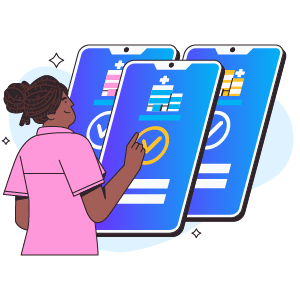Personal Finance / Nursing Student Loan Forgiveness
Higher education is expensive, and getting a nursing degree is no exception. Like many others pursuing a degree, many nurses take out loans, hoping that their income will be high enough for them to be able to pay them off quickly. Unfortunately, debt can become a significant financial burden for nurses, causing them to either pursue supplemental side hustles or to work exhausting overtime shifts.
The good news is that there are many programs offering nursing student loan forgiveness in 2025.
In this article, we’ll cover:
- Nurse Corps Loan Repayment Program
- Public Service Loan Forgiveness Program
- Federal Perkins loan cancellation and discharge
- Military nursing student loan forgiveness
- FAQs
Get job matches in your area + answers to all your nursing career questions

Nurse Corps Loan Repayment Program
A program of the Health Resources and Services Administration, the Nurse Corps Loan Repayment Program is designed for:
- Registered nurses
- Advanced practice registered nurses (such as nurse practitioners)
- Nurse faculty
To qualify, you need to be an RN or APRN working full time for a critical shortage facility or for a nursing school accredited by a national nursing accrediting agency or a state agency recognized by the Secretary of the U.S. Department of Education. Critical shortage facilities are public or private healthcare facilities located in, designated as, or serving a Health Professional Shortage Area as defined by the program.
To be eligible, you must also have received your nursing degree from an accredited nursing school located in a U.S. state or territory. The program pays 60% of unpaid nursing education for a minimum of two years of work, and after those two years of service, a third year of work will make you eligible for another 25% of your unpaid debt. The funds received are subject to state and federal taxes. You can apply for this nursing student loan forgiveness program online.
What counts as a critical shortage facility?
Critical shortage facilities are those located in areas that have a significant shortage of healthcare providers. They can include:
- Native Hawaiian health centers
- Indian health service centers
- End-stage renal disease dialysis centers
- Disproportionate share hospitals
- Urgent care centers
- Certified behavioral health clinics
- Rural health clinics
- Residential nursing homes
- Free and charitable clinics
Public Service Loan Forgiveness Program
The Public Service Loan Forgiveness Program is the most frequently-used nursing student loan forgiveness program. It offers nurses who have made the equivalent of 120 qualifying monthly payments under an accepted repayment plan forgiveness after working full-time for a government or nonprofit employer.
If you work more than one job, you can combine your hours. However, you’ll need to have your employer fill out paperwork to gain eligibility.
To take advantage of the PSLF, change to an income-driven repayment plan. These plans generate your income to figure out your monthly cost. Switching over reduces your payments and can forgive more debt.
How to apply for a PSLF program
After making the 120 qualifying monthly payments and working for the same employer, you can fill out an application. Once you fill out the application, attach it to the employer certification form and mail it to the U.S. Department of Education.
Federal Perkins loan cancellation and discharge
Nurses who have federal Perkins loans and who work full-time may qualify for a 100% loan discharge. Though Perkins loans are no longer granted, nurses who have already taken them out can have their loans canceled.
The loan cancels out over 5 years. To have your loans withdrawn, send an application to the school you received the loan from, or the loan provider.
Military nursing student loan forgiveness
Nurses who have served in the military are eligible for many types of loan forgiveness programs. The Navy and Air Force have programs that can give up to $40,000 a year for nursing student loans. Eligibility depends on the program. Repayment awards are taxed.
To apply, contact your specific military branch for more details.
State nursing student loan forgiveness
Most states have nursing student loan forgiveness programs. Generally, you need to work in a critical needs area to qualify.
Below are several state programs available to nurses:
Alaska
If you live in The Last Frontier state, there’s a SHARP program dedicated to recruiting healthcare providers to work in critical needs areas in exchange for loan assistance.
Medical workers can earn up to $27,000 per year in loan forgiveness based on their positions.
Arizona
The Arizona Loan Repayment Program allows nurses to receive loan assistance to pay off their student loan debt. This program requires a 2-year commitment to provide primary care services in federally designated shortage areas.
Nurses can receive up to $50,000 in funds to help pay back loans for their first 2 years of work.
Florida
Florida nurses who work full-time at eligible organizations have the opportunity to get rid of debt through the state’s Florida provides up to $4,000 per year for a maximum of 4 years.
To be eligible, nurses must be licensed in Florida as an LPN, RN, or APRN.
Illinois
Nurses in Illinois who choose to work in veterans homes may receive loan forgiveness of up to $5,000 per year for a maximum of 4 years.
To be eligible for the Veterans Home Nurse Loan Repayment Program, nurses must:
- Be a resident of Illinois
- Receive employment verification by the Illinois Department of Veterans Affairs
- Meet licensing standards created by the Illinois Department of Financial and Professional Regulation
Iowa
Iowa has a Health Care Loan Repayment Program that offers nurse educators teaching full-time at eligible Iowa colleges and universities, as well as registered nurses and advanced registered nurse practitioners who work in service commitment areas for five consecutive years a maximum annual award of $6,000 per year for up to five consecutive years of full-time employment.
Louisiana
Louisiana’s goal is to recruit healthcare workers to work in rural or urban communities in exchange for loan assistance.
Eligible nurses can receive up to $20,000 annually for a three-year initial commitment. Participants who complete their original three-year commitment in compliance, remain in an eligible site in a HPSA, and still have educational loans to repay may be able to extend their commitment with a two-year renewal to receive $15,000 annually. To qualify, you must have a Louisiana nursing license and not be in default on your loan.
Minnesota
The Minnesota Nurse Loan Forgiveness Program provides repayment to registered or licensed practical nurses who work in a designated nursing home or with people who have developmental disabilities. This program requires a 2-year commitment and can be extended for two additional years. Qualified candidates can receive $6,000 per year.
Montana
The Montana Institutional Nursing Incentive Program provides loan assistance for RNs who work full-time at a Montana state hospital or state prison. Qualified candidates need to submit documentation stating that their loans are more than $1,000.
The final amount awarded depends on state funding. Candidates can only apply for repayment for 4 years.
Oregon
The Oregon Partnership State Loan Repayment Program asks nurses to commit to either two years of full-time service or 4 years of part-time service in a health shortage area. Full-time nurses are eligible for up to $25,000 a year of 50% of their qualifying educational debt. Part-time workers can receive up to $12,500 a year, or 25% of their qualifying educational debt.
Pennsylvania
Through the Pennsylvania Primary Care Loan Repayment Program, Certified Nurse Practitioners and Nurse Midwives who choose to work in federally designated shortage areas can receive loan repayment of up to $48,000 for full-time nurses, while part-time nurses can receive up to $24,000. Candidates must serve at least two years.
Rhode Island
Within the state, nurses may qualify for the Rhode Island Professional Loan Repayment Program. To receive these funds, you must commit to working for 2 years within a shortage area.
Tennessee
Tennessee offers a State Loan Repayment Program to qualified primary care practitioners in exchange for an initial 2-year service obligation to practice full-time or part-time at an ambulatory public, non-profit or private non-profit primary care site located in a federally designated Health Professional Shortage Area (HPSA). To qualify, applicants must:
- Be a Tennessee resident
- Have a Tennessee nursing license
- Must work forty (40) hours a week with no more than eight (8) hours per week spent on practice-related administrative duties or part-time, twenty (20) to thirty-nine (39) hours per week choosing a two (2) or four (4) year service obligation commitment.
Texas
To qualify for the Rural Communities Health Care Investment Program, nurses need to work 12 back-to-back months in a rural community. The maximum payment is $10,000. This is especially helpful for new graduates of Texas nursing programs unsure of how to pay off their loans.
Vermont
Vermont offers a maximum $6,000 educational loan repayment program for nurses. To qualify, you must work 12 months within an under-resourced area. Each nurse also needs to work at least 45 weeks every year, with 20 weeks including clinical hours.
West Virginia
The West Virginia State Loan Repayment Program provides loan assistance for nurses who work full-time for at least two years in under-resourced rural areas. Qualified candidates can earn up to $40,000 for a two-year commitment and an additional $25,000 for two more years if the contract gets extended.
Get job matches in your area + answers to all your nursing career questions

Sources:
“Student Loan Forgiveness.” studentaid.gov. Accessed July 21, 2022.
“Apply to the Nurse Corps Loan Repayment Program.” bhw.hrsa.gov. Accessed July 21, 2022.
“Locations.” ihs.gov. Accessed July 21, 2022.
“Disproportionate Share Hospitals.” hrsa.gov. Accessed July 21, 2022.
“Public Service Loan Forgiveness (PSLF).” studentaid.gov. Accessed July 21, 2022.
“Income-Driven Repayment (IDR) Plan Request.” studentaid.gov. Accessed July 21, 2022.
“Public Service Loan Forgiveness Form.” studentaid.gov. Accessed July 21, 2022.
“Perkins Loans.” studentaid.gov. Accessed July 21, 2022.
“Alaska’s SHARP Program.” health.alaska.gov. Accessed July 21, 2022.
“Loan Repayment Program.” azdhs.gov. Accessed July 21, 2022.
“Nursing Student Loan Forgiveness Program.” floridastudentfinancialaid.org. Accessed July 21, 2022.
“Veterans Home Medical Providers Loan Repayment Program.” isac.org. Accessed July 21, 2022.
“Health Care Award Program.” iowacollegeaid.gov. Accessed July 21, 2022.
“Eligibility and Program Requirements.” michigan.gov. Accessed July 21, 2022.
“Minnesota Long Term Care Nurse Loan Forgiveness Guidelines.” health.state.mn.us. Accessed July 21, 2022.
“Montana Institutional Nursing Incentive Program (MINIP).” mus.edu. Accessed July 21, 2022.
“Oregon Partnership State Loan Repayment Program (SLRP).” ohsu.edu. Accessed July 21, 2022.
“Pennsylvania Primary Care Loan Repayment Program (LRP).” health.pa.gov. Accessed July 21, 2022.
“Graduate Nursing Loan Forgiveness Program.” tn.gov. Accessed July 21, 2022.
“Rural Communities Health Care Investment Program.” texasagriculture.gov. Accessed July 21, 2022.
“Office of Primary Care and Area Health Education Centers (AHEC) Program.” med.uvm.edu. Accessed July 21, 2022.
“State Loan Repayment Program (SLRP).” hsc.wvu.edu. Accessed July 21, 2022.
“The Biden-Harris Administration’s Student Debt Relief Plan Explained.” studentaid.gov. Accessed August 27, 2022.
